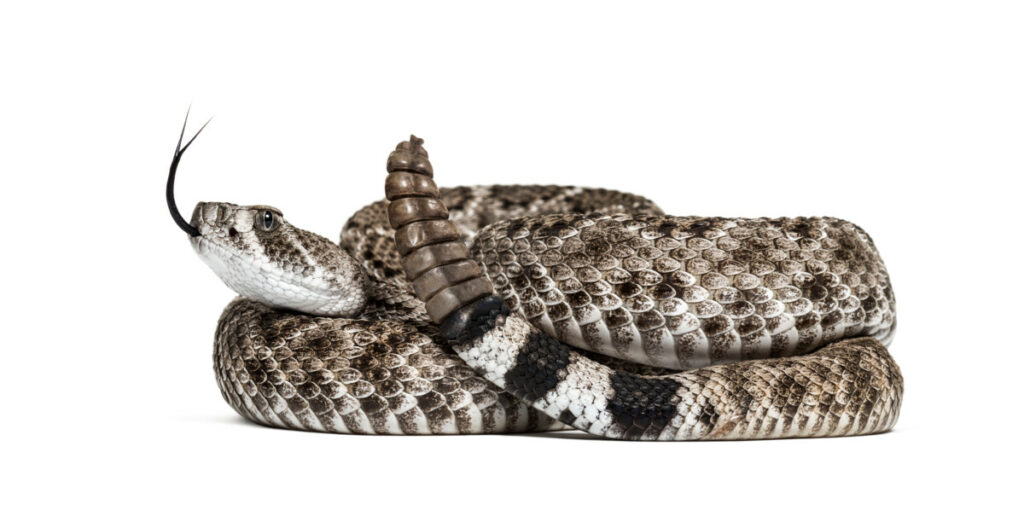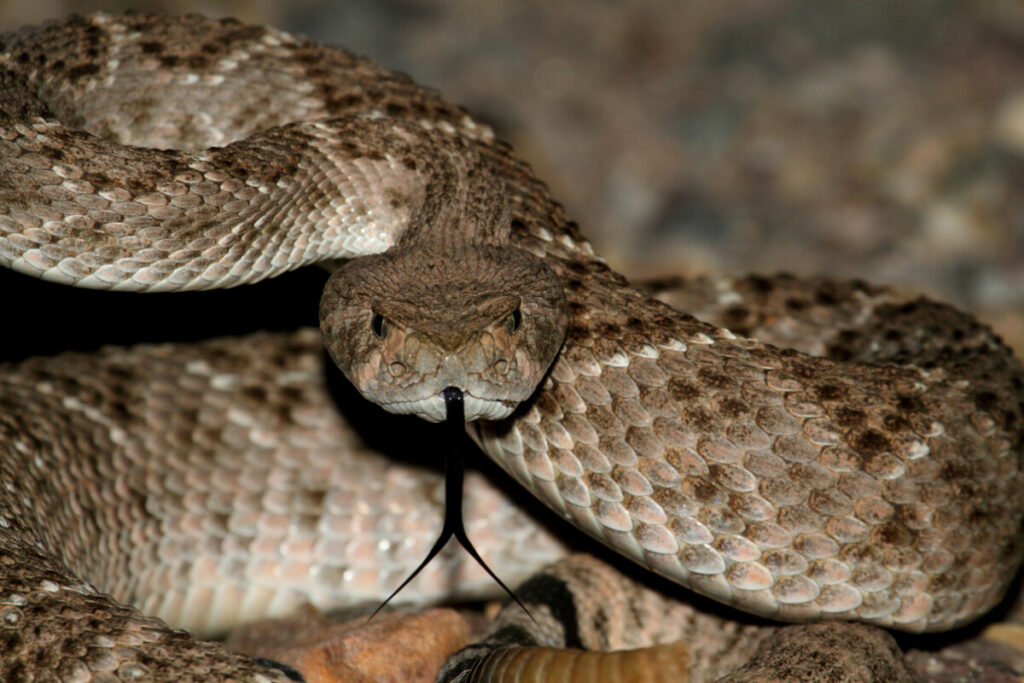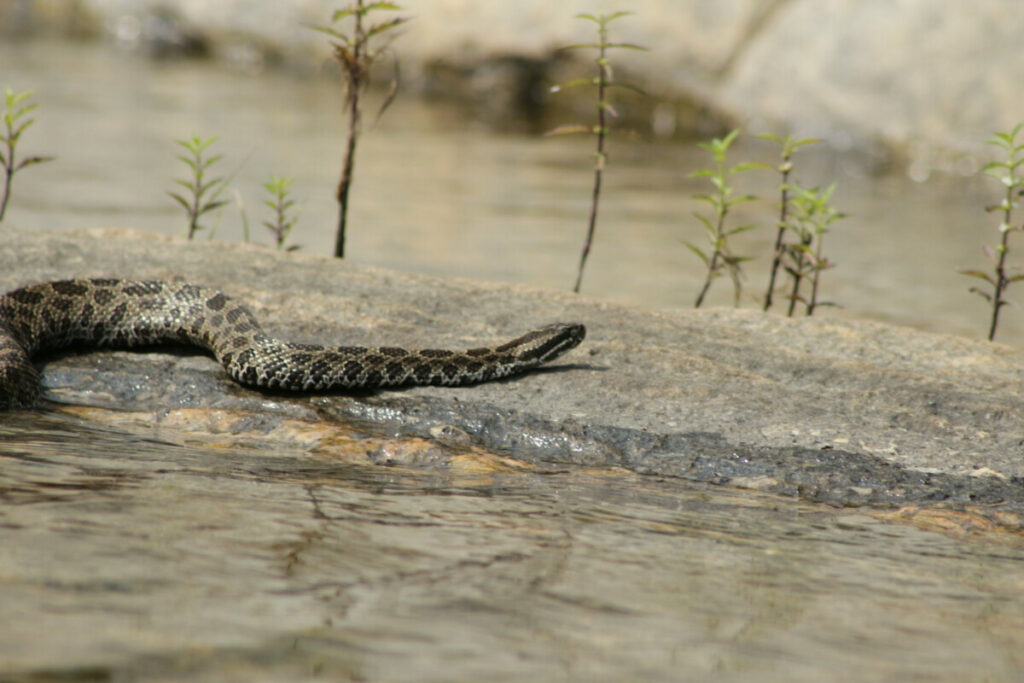
Rattlesnakes are some of the most commonly known and talked about venomous snakes in the U.S., with their various species inhabiting nearly every congruous state. Rattlesnakes have long lifespans when they do not become prey to other animals. But just how long do rattlesnakes live?
A rattlesnake is expected to live from 10 to 20 years in the wild. In captivity, they can live for much longer: from 15 years to 30 years. The oldest living rattlesnake on record was Striker, who was raised by Placer High School for most of his life and died at age 34.
Let’s go more into detail about how long rattlesnakes live, both in the wild and in captivity, what sort of things can limit their lifespan, and whether or not rattlesnakes are endangered.
How Long Do Rattlesnakes Live In the Wild?
Rattlesnakes live much shorter lives in the wild because it’s a wild world out there. On top of having to hunt for food, rattlesnakes are in turn hunted by owls, eagles, hawks, roadrunners, coyotes, bobcats, foxes, and even bigger snakes. Basically, any predator big enough to eat the rattlesnake will do so if it gets the opportunity.
It’s hard to determine how long wild rattlesnakes typically live. There are really only two ways of empirically figuring out a rattlesnake’s lifespan.
The first is to find dead ones and estimate their age based on the size of the rattles. The second is to capture some snakes, implant a radio transmitter in them, and then release them again.
Additionally, the number of rattle segments is an unreliable measurement of age. Rattle segments are added when the snake sheds its skin, which can happen three to four times a year.
Even if the interval is consistent in an individual snake, that length of time between sheddings is not the same for every snake. On top of that, some rattles break off because they are basically made of dry skin.
Rattlesnake Lifespan Is Affected From Being Hunted
The problem with both of these is that one of the main ways a rattlesnake dies in the wild is predation: there are so many different kinds of animals that hunt rattlesnakes to eat, and even if they leave behind the rattle, it can be really hard to find that little thing among leaf litter.
The result is that different sources say very different things about how long to expect the snakes to live in the wild. The National Wildlife Federation says that rattlesnakes typically live for 10 to 25 years, but it’s unclear whether that’s applicable to wild snakes.
Placer Snake Removal gives the more conservative estimate of 7 to 10 years, with the addition that snakes live longer when humans don’t interfere with the snake’s habitat or life. This number likely only applies to snakes local to Placer County in California, but other sources tend to agree with a lifespan closer to 10 years in the wild.
Species-Specific Rattlesnake Lifespan in the Wild
Another reason for conflict about the lifespan of wild rattlesnakes is the variation between species, so here’s a list comparing the lifespans of some rattlesnake species:
- Timber rattlesnakes live for about 10 to 20 years in the wild. If they reached 25 years in the wild, they would not be able to kill their own prey. (Source)
- Prarie rattlesnakes have a life expectancy of 16 to 20 years in the wild. (Source)
- Eastern diamondback rattlesnakes can live 10 to 20 years depending on their size. (Source)
- Western diamondback rattlesnakes are consistently expected to live for around 20 years across many sources.
- Male sidewinder rattlesnakes live for about 13 years, while females live for about 5 years.
- Massasauga rattlesnakes live for about 14 years, but some people might disagree. (Source)
This doesn’t represent even close to all of the different rattlesnake species, but again, it’s hard to estimate lifespans for wild snakes, especially when those snakes prefer to stay hidden.
How Long Do Rattlesnakes Live in Captivity?

When kept in captivity, rattlesnakes are potentially free from all the threats they face in the wild. I say “potentially” because every single condition of their captive environment depends on their keeper. The keeper has to regulate the snake’s habitat temperature, provide the snake with food (including live food), and protect the snake from predators.
The plus side when all that is taken care of is that the snake lives for a lot longer than it otherwise might have. It will never get carried away by a predatory bird, it will never starve ( with proper care ).
In addition, it doesn’t have to work too hard to stay warm. In general, snakes in captivity tend to live much longer than their wild counterparts when properly taken care of.
A Rattlesnake Lifespan Can Exceed 20 Years
When raised in captivity, all of the rattlesnakes listed in the above section are expected to live around 20 years. That includes sidewinder snakes, which had the smallest lifespan of all of the listed species. Many captive snakes live longer than that, and some snakes can live to be over 30 years old given the right conditions.
As you might expect, it’s a lot easier to give snakes a life expectancy when they’re raised in captivity because we have a lot more empirical evidence behind it. It’s so much easier to keep track of how long captive snakes live.
We know when most captive snakes were born, so it’s easy to record how old they were when they passed away. It might not be the first thing on their keeper’s mind when that happens, but it has pretty much solidified 20 as the expected age that a captive rattlesnake can live to be.
What Affects the Lifespan of Rattlesnakes?
There are four things that greatly impact how long a snake can live: predators, food, warmth, and people. Essentially, the length of a snake’s life depends on its ability to sustain itself, to keep out of harm’s way from predators, and whether humans decide to interfere with it.
Being Killed by People
Let’s start with humans since we as a species can cause the most variation in a snake’s life. We tend to do that to nature, and to snakes, it happens in more than one way.
To a lot of people, snakes are scary, especially rattlesnakes. When they come across a snake, they might freak out, and if they have a shovel or other weapon nearby, their first instinct might be to kill the rattlesnake.
That’s the most direct way people kill snakes, but snakes are also killed by cars and when they wander into the path of a lawn mower.
That’s not to mention how land development takes over snake habitats. This is an indirect effect on the snake’s life, but it’s significant because it limits the amount of prey the snake can find. It also effects the places it can find to hide from predators and hibernate.
Predators
As I mentioned above, there are a lot of animals that prey on rattlesnakes: birds of prey, foxes, bobcats, etc. These animals have a different sort of relationship with rattlesnakes than humans do.
The difference is that these predators want to eat the snakes, so they actively try to get near the snake without it noticing.
These predators have adapted to hunt their prey either quickly enough or stealthily enough that their prey doesn’t even get a chance to know it’s there.
Birds of prey typically dive down when they see their prey. Hawks dive down quickly and kill their prey before it has any time to realize it’s in danger. Owls fly silently, so while they might not be as fast as hawks, that silence gives them the stealth they need to get close enough for about the same effect.
Bobcats and foxes are also sneaky hunters, so they can get close enough to a snake they were hunting without the snake noticing. Essentially, when a predator is hunting a rattlesnake, the snake is unlikely to notice it until it is too late to do anything.
Food
Like any animal, snakes need to eat to live. They only need to eat once every two weeks, which is a lot less than most animals, but they still need to eat.
A rattlesnake diet typically eat small mammals, especially rodents, but they will also eat insects and other reptiles. Many animals that rattlesnakes eat are considered pests, like mice and rats.
This limits how long they can live when their habitat is changed and the prey is driven away. Prey might be driven away by pesticides or developments that don’t supply much food.
Warmth
Rattlesnakes are cold-blooded, which means that they can’t regulate their body heat internally. Because of that, they have to spend time out in the sun to warm up.
When the day is overcast, they can’t do that. This habit also has the potential to put them at risk of predators spotting them and snatching them up.
Are Rattlesnakes Endangered?
For the most part rattlesnakes in general are not endangered. While most species of rattlesnake have a stable label of Least Concern in terms of conservation status, there are some exceptions.
Timber Rattlesnake
The timber rattlesnake is one of these exceptions. Also known as the canebrake rattlesnake, these are the second largest venomous snakes in Texas, growing up to 40 inches long.
They like to live in woody places near permanent sources of water like lakes, rivers, and swamps. They like to hide in the tree stumps, logs, and branches.
In Texas, timber rattlesnakes are listed as threatened because of how their habitats are being threatened. Every other state where timber rattlesnakes live also has laws to protect the species as well.
Timber rattlesnakes are also under federal protection, which means it’s illegal to kill them, regardless of the state you’re in.
It’s also illegal to take, transport, sell, or have timber rattlesnakes in your possession. Other threats to the timber rattlesnake population include poaching, illegal pet trade, and people killing them intentionally.
Eastern Massasauga Rattlesnake

Another exception is the eastern massasauga rattlesnakes are also listed as threatened by the U.S. Fish and Wildlife Service, which protects this subspecies under the Endangered Species Act.
Eastern massasaugas can be recognized by their heart-shaped head, dark rings on their tails, and their gray-yellow rattle. They only grow up to be 2 feet long, but they have thick bodies. They like to live in wet places or upland environments depending on the time of year.
Like the timber rattlesnake, their population is threatened by people killing them. Typically because of fear, as well as poaching and illegal trade. Eastern massasaugas are also killed by traffic, mowing, and habitat encroachment.
How You Help Protect Rattlesnakes and Help Insure Proper Lifespans
Rattlesnakes are not aggressive snakes. When they bite humans, they do so because they feel threatened. Even then, they’ll give you a rattling warning before they strike.
This is to tell you that they’re there and you’re too close for comfort.
Rattlesnakes would rather flee than fight, so as long as you don’t get too close or act aggressively, the snake won’t hurt you.
Along with the rattling sound, you can tell a rattlesnake is getting ready to strike when they coil themselves up. Snakes usually coil up in order to push themselves to their target.
So if you spot the snake when it’s not like that, likely you have some time to back up and give it some distance.
Because they are not aggressive and would rather avoid people. One of the best things you can do to protect endangered rattlesnakes is to have that same mindset. Treat rattlesnakes with respect and avoid conflict with them.
Do Your Best Give Rattlesnakes Their Space
Be aware when you’re in a place where you might encounter one. Keep an eye out for snakes when outdoors. If you see a rattlesnake stay calm and give it a respectful amount of distance.
This is why one of the most repeated pieces of hiking advice is to stick to the established trails. Always watch where you’re putting your feet.
The most common reason for a snake to bite is when someone steps too close. Avoid stepping on loose rocks and logs. Snakes like to hide under rocks and logs, and if that rock or log is loose, it will shift around if you step on it.
Basically, keep an eye out, be careful, and be respectful towards rattlesnakes.
